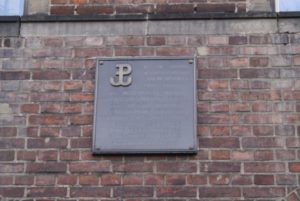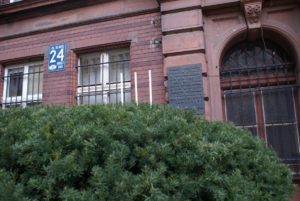Seventy-four years ago at a prison in Kurkowa Street in Gdańsk, the late father Marian Prusak, a parish priest been residing in Gdańsk in those days, gave Last Rites to merely seventeen year old Danuta Siedzikówna aka “Inka”, and the forty two year old Feliks Selmanowicz aka “Zagończyk”, soldiers from Major Zygmunt Szendzielarz “Lupaszka’s” detachment, as they were led to their death.
Following the tracks of the two doomed soldiers who had preferred dying to betraying their comrades in arms I got to the city of Gdańsk in Northern Poland.
“I acted as I should have”
Danuta Siedzikówna aka “Inka” was fifteen years old when she was sworn as a Home Army soldier. It was 1943. Like many other fighters she had been striving to terminate the German occupation. She became an orphan being very young. Her father, who was a forest-ranger was deported to the Soviet Russia. In 1941 he reached the General Anders Army, but died from exhaustion after reaching Teheran. Her mother was arrested in November 1942 and shot by Gestapo in September 1943 for collaborating with the underground. During 1944/1945 Danuta Siedzikówna underwent medical training.
As her nom-de-guerre she chose ‘Inka’, most likely a reference to the powerful and almost unconquerable Inca-people in former Peru.
Like many others couldn`t accept communist regime which was introduced to Poland after the WWII ended. On June the 6th, 1945 she was arrested along with all employees of the forest inspectorate in Hajnówka where she worked for aiding the “forest guerillas” (Polish: “oddział leśny” – Polish Armed Underground Units). While being transported to the UBP (Polish: Urząd Bezpieczeństwa Publicznego – Ministry of Internal Security) headquarters in Białystok she was freed along with a group of prisoners by the reconnaissance unit of the 5th Wilno Brigade of Home Army (AK), at that time subordinated to the Command of the Białystok Region of Home Army lead by Stanislaw Wolonciej “Konus”.
In 1946 she served with the Brigade’s 1st Squadron in Poland’s Pomerania (Polish: Pomorze) region. Acting as a courier, Danuta came to Gdańsk on July the 20th, 1946, where was captured by the secret police. She was arrested and sent to prison. The prosecutors tried to force her to give the names of her contacts in the resistance, but despite the beatings and harshness she kept silent.
On August the 3rd, 1946 Inka was sentenced to death. Three weeks later, less than a week before her eighteenth birthday, she was shot in a cellar of the City Prison. In Danuta’s last secret message she asked fellow prisoners to inform her Grandmother that she “acted as she should have” (Polish: Zachowałam się jak trzeba).
The location of his grave remained unknown for 72 years
Major Franciszek Jerzy Jaskulski aka “Zagończyk” was a soldier in the Home Army and a commander in Freedom and Independence (Polish: Wolność i Niepodległość; a Polish underground anticommunist organization) in the Radom region of Poland. In December 1939 he joined the Union of Armed Struggle (Polish: Związek Walki Zbrojnej; ZWZ), an underground army formed in Poland during the Nazis and Soviet occupation, which transformed into the Home Army (Polish: Armia Krajowa, AK) three years later.
In 1943 after a lot of the Home Army`s units had been exposed by Gestapo in the Radom region, Zagończyk escaped to Lublin where he became the commander of AK units in neighbouring Garwolin.
Let me write a few words for you to see the whole picture and learn more about two cities. Radom is nowadays a city worth a visit for The international Radom Jazz Festival and the International Gombrowicz Theater Festival. And Lublin is a city being recognized for hosting a number of outstanding poets, writers, and historians of the epoch.
But getting back to history. At that time Zagończyk was promoted and transferred to Puławy, a city being known as the seat of the Czartoryskis, Polish princely family, still powerful in Poland. There he had to fight not only with the Germans but also with the Soviet partisans. In 1944 he got promoted to lieutenant and was appointed as the commander of unit called “Pilot”.
Like many other Polish officers and soldiers of the Home Army, Zagończyk was arrested by the NKVD (Eng.: The People’s Commissariat for Internal Affairs in the Soviet Union). He was captured on November 3rd, 1944 and taken to the prison at Lublin Castle (one of the oldest preserved Royal residencies in Poland and what is more ridiculous it was established by High Duke Casimir II the Just – the Just!). On January the 8th, 1945 he was sentenced to death. The main reason for that severe sentence was him being a member of the Home Army, which had fought for independence of Poland from the Soviet Union, which didn’t want Poland to be an independent, free country anymore. Two weeks later the death penalty was annulled and his sentence was commuted to 10 years of imprisonment. In September 1945 he escaped from the prison in Wronki by taking advantage of the fact that he was working outside of prison grounds.
After his escape Zagończyk returned to Puławy. At those times underground army was scattered and divided into lots of small units, fighting on their own, without one strong aim. Many young people were escaping to forests and becoming guerillas in order to avoid being arrested or killed by NKVD and Red Army. After a few weeks Zagończyk got an order to move to Kozienice region and take command of units in that region. On October the 22nd, 1945 he took part in unsuccessful attempt to liberate the Home Army’s soldiers from communist prison in Dęblin. At the very beginning Zagończyk was commanding the units in Puławy region but soon he became the commander of them in the whole Radom region. He was also the commander of organization called The Armed Combat Union (Polish: Związek Zbrojnej Konspiracji). The main aim of this organization was to fight with Soviets, inform people about real situation of the country. They were issuing many leaflets informing soldiers and people living at the Radom region about situation both in Poland and Europe. That action was to help to win the referendum in 1946. All attempts were useless because the communists had falsified the results of referendum. But Zagończyk and his soldiers was still fighting with communists and units of Citizen’s Militia (Polish: Milicja Obywatelska, MO). Probably you can recognize MO on some photographs taken by famous photographer Chris Niedenthal during the martial law imposed on Poland on December 13th, 1981.
And once again a few words for you to get to know more about my country. Kozienice is where Poland’s second largest coal-fired thermal Kozienice Power Station is located. And Dęblin is one of the most important places associated with aviation in Poland.
And back to Zagończyk story. On July the 24th, 1946 he liberated prisoners from railway transport near Jedlnia-Letnisko (just 57 miles south of Warsaw). There was suspicion that the action was inspired by communists in order to arrest him. Two days later Zagończyk was captured and took into custody. Communists tried to force him to give names of people who were also involved in fight with them. Zagończyk refused that. On January the 11th, 1947 he was sentenced to death.
***
He was executed in secrecy and the location of his grave as long as Inka`s one remained unknown for 72 years. Inka was very young when she was shot. Zagończyk was married and orphaned three children.
None of them were bandits. They were heroes. Zagończyk got Virtuti Militari Order and The Cross of Valour, the highest Polish military decorations for courage in the face of the enemy. He got both decorations for fighting against the Germans.
The communists did a lot to destroy their enemies
As Krzysztof Szwagrzyk, president of the Public Information Bureau of the Institute of National Remembrance regional Chapter in Wrocław said: “That was a surprise to us […] we thought finding Inka and Zagończyk would be practically impossible. The only woman with a hole in the skull should be Inka. A very young woman, a girl, we should say. Doctor Łukasz Szleszkowski of the forensic medicine department in Wrocław has found she even had a milk tooth.
The analysis of the DNA took a lot of time, but they confirmed that at the cemetery at Giełguda street in Gdańsk, under the lawn and under the pavement at sector number 14, they had found the remains of Feliks Selmanowicz and Danuta Siedzikówna, who were killed on the same day on August the 28th, 1946 at the prison in Gdańsk.
The communists did a lot to destroy their enemies. They did a lot to ascribe certain features and deeds to them, so that society would believe they were criminals. The communist also did a lot to leave no trace of the places where their enemies were buried.”
(source: “Polish heroes honoured” at www.thenews.pl)
There are a lot of unknown graves of doomed soldiers around Poland. And not only them.
A priest who turned himself in and was executed by a firing squad
Rev. Gurgacz was a Jesuit priest who was condemned to death and executed by the communists in 1949. Władysław Gurgacz was a member of the Society of Jesus, and chaplain of the anti-communist underground. He recognised his calling at the age of 17, and was ordained in 1942.
After WWII, he disapproved communist regime in Poland what brought him immense popularity among believers. Between 1947 to 1948 he worked as a hospital chaplain in Krynica, paradoxically the biggest spa town in Poland often called the Pearl of Polish Spas. Paradoxically because it was where he joined PPAN, an armed unit of anti-communist underground Polish opposition; specifically, the Polish Underground Independency Army (Polish: Polska Podziemna Armia Niepodległościowa. . And where was the beginning of the end of rev. Władysław Gurgacz`s life. He was convinced that it was his duty to offer spiritual care to the organisation’s members. His actions caused consternation in some quarters of the Church, but he resolved to stay with the partisan movement come what may.
He was awarded the rank of captain. While serving with the army he convinced partisans not to carry out executions of Soviet NKVD collaborators and members of Polish Workers’ Party, who were beaten and forced to eat communist party identity cards. On July the 2nd, 1949, the partisans conducted operation against a Communist-controlled bank in Kraków in order to gain money needed to escape to Western Europe. They were caught and arrested by the Office of Public Security, and later in a show trial sentenced to death by two judges Władysław Stasica and Ludwik Kiełtyka. Although Gurgacz did not participate in the operation, he turned himself in and was executed by a firing squad on September the 14th, 1949 in Montelupich prison in Kraków. In his court statement he said:
[…] these young people whom you are judging and slanderously call “bandits” are not the criminals. They are the defenders of their country! I don’t regret what I did. My actions were dictated by what the millions of Poles, whose fate was sealed by the NKVD’s bayonets, think. I’ll gladly go to my death. What is death, after all? I believe that each and every drop of the innocent blood you spilled will give birth to thousands of others who will [raise to] oppose you […]”
source: http://www.doomedsoldiers.com/
Excerpt from the Reverend Władyslaw Gurgacz’s statement to the communist court in 1949
The body of Rev. Gurgacz was never returned to his family and his burial place remains unknown. However a lot of Polish cities have memorials to him, as one of the most important figures associated with PPAN. His sacrifice is considered so stupendous that he was posthumously awarded the Commander’s Cross, in 2008. The letter of citation sums up his bravery, stating:
“Father Gurgacz knew, that by joining the ranks of the Polska Podziemna Armia Niepodleglosciowa, he closed the door to any possibility of return to normal life. In the name of God’s love, and in the name of love for his country, he chose the fate of the doomed; those doomed by the communist propaganda, and those stripped from the protections of law. He chose the fate of those who were unceasingly hunted by the [communist] security apparatus, those who were mercilessly attacked, and when arrested, the fate of those inhumanly tortured and remanded to execution. [Rev. Gurgacz] didn’t hesitate to take this path, and remained faithfully on it until the very end.
Late Lech Aleksander Kaczyński, President of the Republic of Poland”
Kurkowa City Prison, Gdańsk
Kurkowa City Prison is where I got on my research trip. That is still working jail without admission to the public.

During WWI some political prisoners were incarcerated there, including the Polish military officer, statesman and freedom fighter Józef Piłsudski, the most influent personality during the interwar period in Poland.
In 1933 the local Nazi Party took over the City’s government. The German majority in Gdansk resented the Polish minority and their democratic opposition and due to the nazification many democrats ended up in the City Prison. After the German invasion of Poland on September the 1st, 1939 over 800 Poles from Gdańsk and Pomerania were incarcerated in the prison, and often severely maltreated. Overall during the war over 29.000 people served time in the City Prison; 500 of them were executed or died of mistreatment.
After 1945 the prison was taken over by the Polish Communist security services that were not better than the Nazis. There were all kinds of inmates. Among the prisoners were war criminals like the Gauleiter of Gdańsk Albert Forster, the guards of the Stutthof concentration camp, like Jenny-Wanda Barkmann, as well as members of the Polish anti-communist resistance. Some of these were executed in the prison, including – as you know – Danuta Siedzikówna, alias ‘Inka’. The Communist political police retained ownership of one of the prison blocks until its disbandment in 1989. Commemorative plaques were placed on the prison wall, documenting the historical events and the names of persons who were incarcerated.


“Crimes in the Majesty of Law”
“Crimes in the Majesty of Law” refers to abuses of the citizens of a state, as directed by a judicial or administrative agent of the state, on the false representation that the abuse was legally authorized. This definition, while reasonably concise, is beset by the ambiguity of how to define “abuse” and “law”. Empirically, law is best defined in John Austin’s Utilitarian formulation “commands, backed by threat of sanctions, from a sovereign, to whom people have a habit of obedience”. “Sovereign”, itself, has been superseded and this might read for modern ears as “commands, backed by threat of sanctions, from a political power, to which people have a habit of obedience”.
“Law is what you can get away with calling law”
PRL (Polish: Polska Rzeczpospolita Ludowa – Eng.: People’s Republic of Poland; Polish Communist government) and MBP (Polish: Ministerstwo Bezpieczeństwa Publicznego – Eng.: Ministry of Public Security [of Poland]; Polish Communist: secret police, intelligence and counter-espionage) certainly had political power; they ventured sanctions aplenty. Nonetheless the Poles had never had a habit of obedience to them. This was established by the long history of resistance, insurgency and hostility to them leading to the fall of the PRL, and re-establishment of Rzeczpospolita Polska (Eng.: The Republic of Poland; Polish Patriot: constitutional government pre-war, in exile and post-PRL)
The greatest abuse was the PRL adjudication of Polish Patriotic forces as “traitors”, with the object of executing them. Clearly, facing such an adjudication in a spurious court, many Patriots determined to fight in a guerilla action. By and large, these guerillas avoided edging into the role of terrorists. That distinction has been obscured of late, but the distinction lies the target of an attack. Soldiers and police of a state, or the state’s logistical basis in transportation and communications is a form of war, and here guerilla war.
***
The best description of those years was delivered by Julia Brystiger vel. “Bloody Luna,” Polish secret police interrogator famed for her sadistic, Gestapo-like, treatment of political prisoners in Poland.
“[…] the Polish intelligentsia as such is against the Communist system and basically, it is impossible to re-educate it. All that remains is to liquidate it. However, since we must not repeat the mistake of the Russians after the 1917 revolution, when all intelligentsia members were exterminated, and the country did not develop correctly afterwards, we have to create such a system of terror and pressure that the members of the intelligentsia would not dare to be politically active.” Thanks God it is not longer an issue.
By Agata Szostkowska
Photos: Michał Stanisławski © Copyright www.communications-unlimited.nl, 2020. All rights reserved.
Source: Central and Eastern Europe Center: Communications-Unlimited.nl © Copyright www.communications-unlimited.nl, 2020. All rights reserved.

Follow Us!